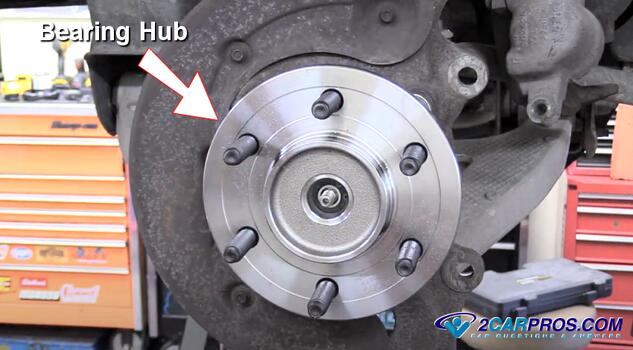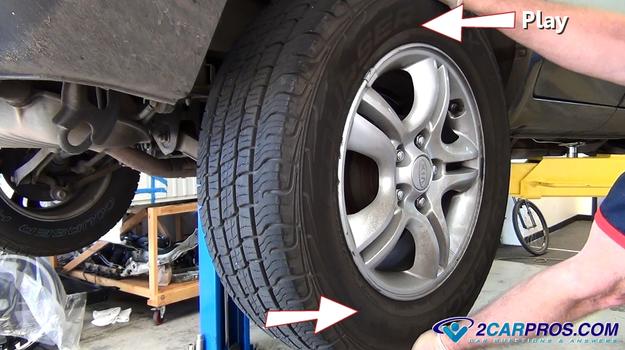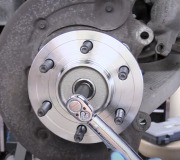Wheel bearing hubs, or bearing hubs are used to support the vehicle while allowing the wheels to roll, they also can contain ABS wheel speed sensors. In this guide we will go over all you need to know about how and why bearing hubs fail. This is good to know because if this problem is left unattended it can cause the wheel to lock up, pull to one side, and in extreme cases fall off. We will start with the most common symptoms and work are way to the more obscure.
Bad Wheel Bearing Hub Symptoms
1. Humming Noise: Also known as grumbling, when the bearing hub starts to go bad the ball bearings inside the hub start to fall apart causing the abnormal noise. The pitch of the noise can change as you gently move the steering wheel back and forth as you travel in a straight line. It can also be more prevalent turning either right or left and help tell you which side of the car the problem is on.
2. Clicking Noise: Once the grumbling stops it can be replaced by a clicking noise which means the metal partials of the ball bearings are being smashed by the weight of the vehicle as it travels.
3. ABS/ Traction Control Warning Light On: This can seem strange that a bad bearing can cause these ABS warning lights to be on, but this is why. The ABS wheel speed sensor is mounted to the spindle or housing so it can give feedback data to the ABS computer. On the axle is a reluctor ring that has teeth which are counted by the traction control and ABS systems. If the sensor becomes misaligned by the bad bearing hub the rotational speed of the wheel can not be counted accurately which illuminates the warning lights. This problem may first present itself when turning a corner, either right or left. So, when you replace the wheel bearing hub it will fix two problems at once.
4. Play in Front or Rear Wheels: While most cars have bearing hub in the front, cars with front wheel drive will have them at the rear wheels as well. Sometimes a bearing hub failure will make no noise, got figure, so if when jacking up your vehicle you can grasp the wheel top and bottom and notice "play" in the wheel the bearing hub is bad.
5. Pulling to One Side: When a bearing hub goes bad, it will hinder the ease of rotation either on the right or left side depending on the side with the bad bearing. Much like a shopping cart with a front wheel jammed, it will tend to pull in the direction of the stuck wheel, this sensation can come and go.
6. Brake Pedal Goes to the Floor: This seems strange to some as well, but if the brake rotor is not held true it can move the brake pads back into the brake caliper affectively creating an air gap between the caliper piston and brake pads. This air gap is taken up by brake fluid which must be pumped in by the brake pedal, AKA the brake master cylinder, which gives the impression of a low brake pedal even though there is nothing wrong with the brake system.
7. Steering Wheel Vibration: When the bearing hub has failed it can cause the front wheels not to run "true" resulting in uneven pressure on the steering wheel which can have a "dance like sensation" in the steering wheel at freeway speeds due to the excessive play in the rotational mass, (tire).
8. Uneven Tire Wear: Hopefully you have found the problem before tire wear becomes an issue, but if not this condition can cause the inside of the tire to wear excessively due to the lateral force on the tire which can increase the camber of the tire. The normal camber measurement which should be about 2 degrees positive, can increase to about 15 degrees positive. This will cause the car to ride on the very inside of the tire, hence the bad tire wear pattern.
Premature Failure
If larger tires have been installed on a vehicle it adds leverage to the bearing hubs. This will cause the wheel bearing hub to wear out many times faster then if the stock tires were left on the vehicle, as you could guess this is a big problem with lifted trucks and SUV's. There is no fixed for this "large wheel" problem except for to keep changing the bearing hubs out.
Failure Risks
Never ignore a bad wheel bearing hub, if left "unchecked" it can cause you to lose control of the car as the affected wheel tries to lock up, or the brakes will become unresponsive, or the wheel could fall off completely, all bad scenarios for any driver.
Credits
This guide knowledge base was created by the 2CarPros Team, and by Ken Lavacot: Automobile repair shop owner and certified master automobile technician of over 30 years. If you have question or need help please ask one of our experts we are happy to help. Please visit our 2CarPros YouTube Channel.





